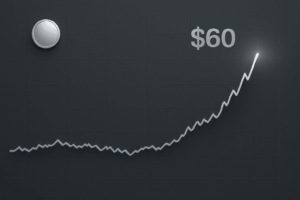Mike Maloney believes we’re witnessing the most significant turning point in the silver market’s history — and his latest video, Understand the Silver Squeeze, reveals why.
From London to Tokyo, silver lease rates are skyrocketing — now higher than platinum’s — as bullion banks struggle to find metal to lend. “Nobody’s got silver,” one market insider told Mike. “Lease rates are 20 to 30 percent if you’re lucky enough to find a lender.”
That’s not normal. It’s a sign of deep, systemic stress. For the first time in decades, even the largest players are admitting that there’s “no free-floating silver left” — meaning the available physical supply for delivery has all but vanished.
The 45-Year ‘Cup and Handle’ Breakout
Maloney reveals a chart that’s been more than four decades in the making — a 45-year “cup and handle” formation that has now completed.
“This pattern predicts triple-digit silver,” Mike explains, “and I think we’re heading toward the mid-triple digits.”
In plain terms, the long-term technical setup for silver has finally broken out of resistance that’s held since 1980. Prices have already doubled from their 2022 lows, and the structural forces driving the market — from central bank policy to physical shortages — are accelerating.
Paper Markets Are Cracking Under Pressure
The “paper” silver market — futures and ETFs like SLV — is showing signs of strain. Borrowing fees for SLV shares have exploded from a typical 0.5% to over 12%, with zero shares left available to borrow.
Meanwhile, backwardation — when the spot price of silver trades higher than futures contracts — has reached levels never seen before. At one point, spot silver was up $1.40 while the front-month futures contract rose only 20 cents.
That disconnect tells you everything: investors want real, physical silver now — not a promise to deliver later.
And when markets go from promises to possession, the paper side starts to disintegrate.
Refinery Bottlenecks and the Coming Physical Shortage
Even with strong mine output, refineries are choking on demand. Backlogs are running four weeks or more, meaning there’s plenty of raw silver (in “doré” bars), but not enough refined metal to meet investor demand.
This bottleneck limits supply of coins, 10-ounce bars, and 1,000-ounce wholesale bars — the backbone of both retail and institutional markets.
As Mike puts it: “If refineries can’t process the metal fast enough, prices have to rise.”
It’s a feedback loop: suppressed prices slowed mining, mining shortfalls created scarcity, scarcity led to refining gridlock — and now that real demand is back, the market’s out of metal.
History Is Repeating — But on a Bigger Scale
Footage out of Australia already shows lines forming outside bullion shops, just as they did in 1980. In Sydney, one queue stretched around the block as investors rushed to secure physical metal.
“This is the great gold and silver rush of the 21st century,” Mike says. “They can manipulate the paper markets all they want, but they can’t control this crowd. People want to hold real silver in their hands.”
For decades, price suppression kept silver undervalued — a gift for long-term investors. But now, the cracks are widening, and the physical market is taking control.
Are We Seeing Another 1980-Style Silver Rush?
After 45 years of buildup, the silver market may finally be breaking free from decades of artificial pressure.
Whether this leads to a new all-time high or the beginning of a mid triple-digit era, one thing is clear: the world is waking up to real money again.
Watch Mike’s full analysis: Understand the Silver Squeeze.
People Also Ask
What is causing the current silver squeeze?
The current silver squeeze is being driven by a combination of exploding physical demand, refinery bottlenecks, and a shortage of “free-floating” silver available for delivery. Lease rates and borrowing costs for silver have spiked, showing that large institutions are struggling to source metal. Learn more in Mike Maloney’s full breakdown: Understand the Silver Squeeze
What does “no free-floating silver left” mean?
When analysts say there’s “no free-floating silver left,” it means nearly all available physical silver is already spoken for—held in vaults, ETFs, or by investors unwilling to sell. It’s a signal that supply is tightening while demand remains strong.
Why is silver trading above futures prices (backwardation)?
Backwardation happens when spot silver trades higher than futures contracts, showing buyers are willing to pay more for immediate delivery. It’s rare — and it often means physical demand is overwhelming paper supply.
How high could silver prices go during a global squeeze?
Mike Maloney believes the 45-year “cup and handle” pattern points to mid triple-digit silver if physical shortages continue and paper markets lose credibility. While no one can predict exact timing, the setup suggests historic upside potential. Mike says we could see triple-digit silver sooner than you may think.
What should investors know before buying physical silver?
Investors should understand the difference between paper silver (like ETFs) and physical bullion, as only the latter offers true protection against market manipulation or counterparty risk. GoldSilver.com provides trusted guidance and educational resources for both new and experienced investors.
Get Gold & Silver Insights Direct to Your Inbox
Join thousands of smart investors who receive expert analysis, market updates, and exclusive deals every week.








